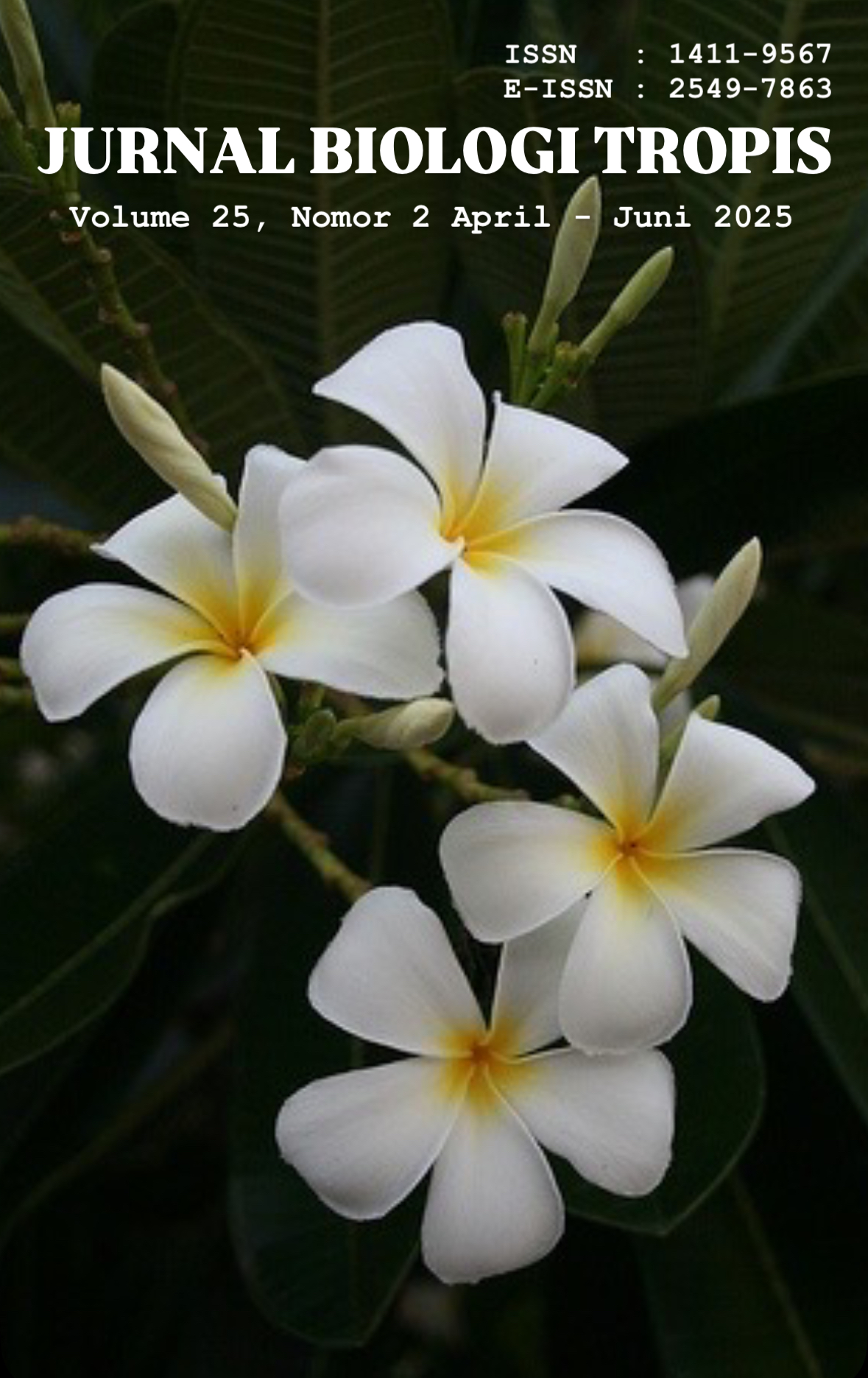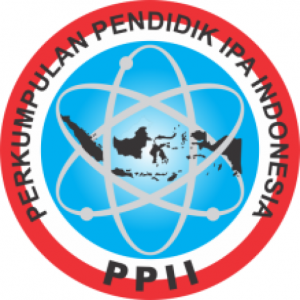Investigation of Flavonoid Levels of Black Rice from Rice (Oryza sativa L.) on Sumba Island
Authors
Jennilien Merinda Ghello , Gregorio Antonny BaniDOI:
10.29303/jbt.v25i2.8817Published:
2025-05-22Issue:
Vol. 25 No. 2 (2025): April-JuniKeywords:
Black rice, flavonoids, wojalaka, Sumba.Articles
Downloads
How to Cite
Downloads
Metrics
Abstract
Rice (Oryza sativa L.) is Indonesia’s main cereal crop and is classified into three types based on color: white, red, and black. Among these, black rice has the highest antioxidant content. As a secondary metabolite, antioxidant levels vary depending on regional characteristics. On Sumba Island in East Nusa Tenggara, black rice known as Wojalaka grows across four districts with distinct environmental conditions. This study aimed to evaluate the flavonoid content of Wojalaka black rice from these districts. Using UV-Vis spectrophotometry, ground rice samples were extracted via methanol maceration and analyzed through linear regression. The flavonoid levels found were West Sumba (Lamboya) 74.03 µg/L; Southwest Sumba (Kodi) 67.67 µg/L; Central Sumba (Umbu Ratunggai) 31.65 µg/L; and East Sumba (Matawai) 132.16 µg/L. The highest flavonoid concentration was observed in Matawai at 132.16 µg/L, while the lowest was in Umbu Ratunggai at 31.65 µg/L. These results indicate that flavonoid content depends on habitat conditions the drier the environment where the rice grows, the higher its flavonoid levels.
References
Alum, E. U. (2024). Climate change and its impact on the bioactive compound profile of medicinal plants: implications for global health. Plant Signaling and Behavior, 19(1), 4–6. https://doi.org/10.1080/15592324.2024.2419683
Anasthasia Pujiastuti, Agitya Resti Erwiyani, & Istianatus Sunnah. (2022). Perbandingan Kadar Flavonoid Total dan Aktivitas Antioksidan Ekstrak Labu Kuning dengan Variasi Pelarut. Journal of Holistics and Health Science, 4(2), 324–339. https://doi.org/10.35473/jhhs.v4i2.215
Anggraeni Putri, P., Chatri, M., & Advinda, L. (2023). Karakteristik Saponin Senyawa Metabolit Sekunder pada Tumbuhan. Jurnal Serambi Biologi, 8(2)(2), 251–258.
Baozhu, L., Ruonan, F., Yanting, F., Runan, L., Hui, Z., Tingting, C., Jiong, L., Han, L., Xiang, Z., & Chun-peng, S. (2022). The flavonoid biosynthesis regulator PFG3 confers drought stress tolerance in plants by promoting flavonoid accumulation. Environmental and Experimental Botany, 196, 104792. https://doi.org/https://doi.org/10.1016/j.envexpbot.2022.104792
Basith, A., Noer, S., & Faizah, M. (2023). Variation in anthocyanin content level in four local varieties of black rice (Oryza sativa L.) from Indonesia. Jurnal Pertanian, 14(1), 1–6. https://doi.org/10.30997/jp.v14i1.7152
Cañizares, L., Meza, S., Peres, B., Rodrigues, L., Jappe, S. N., Coradi, P. C., & Oliveira, M. de. (2024). Functional Foods from Black Rice (Oryza sativa L.): An Overview of the Influence of Drying, Storage, and Processing on Bioactive Molecules and Health-Promoting Effects. Foods, 13(7). https://doi.org/10.3390/foods13071088
Chaouqi, S., Moratalla-López, N., Alonso, G. L., Lorenzo, C., Zouahri, A., Asserar, N., Haidar, E. M., & Guedira, T. (2023). Effect of Soil Composition on Secondary Metabolites of Moroccan Saffron (Crocus sativus L.). Plants, 12(4). https://doi.org/10.3390/plants12040711
Ciumărnean, L., Milaciu, M. V., Runcan, O., Vesa, S. C., Răchisan, A. L., Negrean, V., Perné, M. G., Donca, V. I., Alexescu, T. G., Para, I., & Dogaru, G. (2020). The effects of flavonoids in cardiovascular diseases. Molecules, 25(18), 1–18. https://doi.org/10.3390/molecules25184320
Das, M., Dash, U., Mahanand, S. S., Nayak, P. K., & Kesavan, R. K. (2023). Black rice: A comprehensive review on its bioactive compounds, potential health benefits and food applications. Food Chemistry Advances, 3(September 2022), 100462. https://doi.org/10.1016/j.focha.2023.100462
Ensiklopedia Dunia. (2018). Pulau Sumba. In Ensiklopedia Dunia. https://p2k.stekom.ac.id/ensiklopedia/Pulau_Sumba
Febram Prasetyo, B., Madyastuti Purwono, R., & Valgar Novarino, A. (2021). Potensi Antioksidan Menggunakan Metode DPPH Ekstrak Beras Hitam (Oryza Sativa L Indica) dan Penghambatan Tirosinase. Jurnal Health Sains, 2(9), 1132–111140. https://doi.org/10.46799/jhs.v2i9.281
Fitriyah, D., Ayu, D. P., Puspita, S. D., Yuanta, Y., & Ubaidillah, M. (2022). Analisis Kandungan Senyawa Bioaktif, Nutrisi dan Aktivitas Antioksidan pada Minuman Ekstrak Beras Hitam. ARTERI : Jurnal Ilmu Kesehatan, 3(1), 21–30. https://doi.org/10.37148/arteri.v3i1.204
Hanas, D. F., Kriswiyanti, E., & Junitha, I. K. (2017). Karakter Morfologi Beras Sebagai Pembeda Varietas Padi. Indonesian Journal of Legal and Forensic Sciences (IJLFS), 7, 23. https://doi.org/10.24843/ijlfs.2017.v07.i01.p04
Haruni, S. A., Padjung, R., Musa, Y., Farid, M., Anshori, M. F., & Fadhilah, A. N. (2024). Functional food biofortification in increasing red and black rice production through the use of nano silica organic fertilizer. Chilean Journal of Agricultural Research, 84(3), 362–371. https://doi.org/10.4067/S0718-58392024000300362
Iswanti, W., Budijanto, S., & Abdullah, M. (2024). Flavonoid and Antioxidant Activity Analysis of Anthocyanin Black Rice Bran Extract (Abribe) Cv Cempo Ireng Origin From Indonesia. Journal of Microbiology, Biotechnology and Food Sciences, 14(2), 1–6. https://doi.org/10.55251/jmbfs.10203
Jin, Z., Tao, Y., Yue, R., Ma, Z., Cheng, S., Khan, M. N., & Nie, L. (2024). Trade-off between grain yield and bioactive substance content of colored rice under coupled water and nitrogen conditions. Field Crops Research, 309, 109312. https://doi.org/https://doi.org/10.1016/j.fcr.2024.109312
Kubra, G., Khan, M., Munir, F., Gul, A., Shah, T., Hussain, A., Caparrós-Ruiz, D., & Amir, R. (2021). Expression Characterization of Flavonoid Biosynthetic Pathway Genes and Transcription Factors in Peanut Under Water Deficit Conditions. Frontiers in Plant Science, 12(June), 1–18. https://doi.org/10.3389/fpls.2021.680368
Kusnadi, K., & Devi, E. T. (2017). Isolasi dan Identifikasi Senyawa Flavanoid Pada Ekstrak Daun Seledri (Apium graveolens L.) Dengan Metode Refluks. PSEJ (Pancasakti Science Education Journal), 2(1), 56–67. https://doi.org/10.24905/psej.v2i1.675
Laoué, J., Fernandez, C., & Ormeño, E. (2022). Plant Flavonoids in Mediterranean Species: A Focus on Flavonols as Protective Metabolites under Climate Stress. Plants, 11(2). https://doi.org/10.3390/plants11020172
Liang, C., Guan, Z., Wei, K., Yu, W., Wang, L., Chen, X., & Wang, Y. (2023). Characteristics of antioxidant capacity and metabolomics analysis of flavonoids in the bran layer of green glutinous rice (Oryza sativa L. var. Glutinosa Matsum). Scientific Reports, 13(1), 1–12. https://doi.org/10.1038/s41598-023-43466-3
Mapoung, S., Semmarath, W., Arjsri, P., Thippraphan, P., Srisawad, K., Umsumarng, S., Phromnoi, K., Jamjod, S., Prom-u-Thai, C., & Dejkriengkraikul, P. (2023). Comparative analysis of bioactive-phytochemical characteristics, antioxidants activities, and anti-inflammatory properties of selected black rice germ and bran (Oryza sativa L.) varieties. European Food Research and Technology, 249(2), 451–464. https://doi.org/10.1007/s00217-022-04129-1
Maulani R, Sumardi D, & Pancoro A. (2019). Total flavonoids and anthocyanins content of pigmented rice. Drug Invention Today , 12(2), 369–373. https://www.researchgate.net/publication/334249256
Minocha, T., Birla, H., Obaid, A. A., Rai, V., Sushma, P., Shivamallu, C., Moustafa, M., Al-Shehri, M., Al-Emam, A., Tikhonova, M. A., Yadav, S. K., Poeggeler, B., Singh, D., & Singh, S. K. (2022). Flavonoids as Promising Neuroprotectants and Their Therapeutic Potential against Alzheimer’s Disease. Oxidative Medicine and Cellular Longevity, 2022. https://doi.org/10.1155/2022/6038996
Najmah, N., Fitria, R., & Kurniawati, E. (2023). Skrining Fitokimia, Total Flavonoid dan Fenolik Daun Sereh Wangi (Cymbopogon nardus (L.) Rendle). Jurnal Crystal : Publikasi Penelitian Kimia Dan Terapannya, 5(1), 62–70. https://doi.org/10.36526/jc.v5i1.2642
Nurmila, Sinay, H., & Watuguly, T. (2019). Identifikasi dan Analisis Kadar Flavonoid Ekstrak Getah Angsana ( Pterocarpus indicus Willd ). Jurnal Biopendix, 5(2), 65–71.
Ridwanuloh, D., & Syarif, F. (2019). Isolation and identification of flavonoid compounds from ciplukan stem (Physalis angulata L.). Pharma Xplore : Jurnal Ilmiah Farmasi, 4(1), 287–296.
Sarma, B., Kashtoh, H., Lama Tamang, T., Bhattacharyya, P. N., Mohanta, Y. K., & Baek, K. H. (2023). Abiotic Stress in Rice: Visiting the Physiological Response and Its Tolerance Mechanisms. Plants, 12(23), 1–41. https://doi.org/10.3390/plants12233948
Shomali, A., Das, S., Arif, N., Sarraf, M., Zahra, N., Yadav, V., Aliniaeifard, S., Chauhan, D. K., & Hasanuzzaman, M. (2022). Diverse Physiological Roles of Flavonoids in Plant Environmental Stress Responses and Tolerance. Plants, 11(22). https://doi.org/10.3390/plants11223158
Suryanti, V., Riyatun, Suharyana, Sutarno, & Saputra, O. A. (2020). Antioxidant activity and compound constituents of gamma-irradiated black rice (Oryza sativa l.) var. cempo ireng indigenous of Indonesia. Biodiversitas, 21(9), 4205–4212. https://doi.org/10.13057/biodiv/d210935
Thanuja, B., & Parimalavalli, R. (2020). Comparison of Anti-Oxidant Compounds and Antioxidant Activity of Native and Dual Modified Rice Flour. International Journal of Pharmaceutical Sciences and Research, 11(3), 1203. https://doi.org/10.13040/IJPSR.0975-8232.11(3).1203-09
Thepthanee, C., Liu, C.-C., Yu, H.-S., Huang, H.-S., Yen, C.-H., Li, Y.-H., Lee, M.-R., & Liaw, E.-T. (2022). Antioxidant Activity and Inhibitory Effects of Black Rice Leaf on the Proliferation of Human Carcinoma Cells. BioMed Research International, 2022, 7270782. https://doi.org/10.1155/2022/7270782
Yang, L., Yang, L., Yang, X., Zhang, T., Lan, Y., Zhao, Y., Han, M., & Yang, L. (2020). Drought stress induces biosynthesis of flavonoids in leaves and saikosaponins in roots of Bupleurum chinense DC. Phytochemistry, 177, 112434. https://doi.org/https://doi.org/10.1016/j.phytochem.2020.112434
Yang, X., Lu, M., Wang, Y., Wang, Y., Liu, Z., & Chen, S. (2021). Response mechanism of plants to drought stress. Horticulturae, 7(3). https://doi.org/10.3390/horticulturae7030050Alkoaik, F. (2005). Fate of plant pathogens and pesticides during composting of greenhouse tomato plant residues. Unpublished dissertation in partial fulfillment of the requirements for the degree of Doctor of Philosophy, Dalhousie University, Halifax, Nova Scotia, Canada
License
Copyright (c) 2025 Gregorio Antonny Bani, Jennilien Merinda Ghello

This work is licensed under a Creative Commons Attribution 4.0 International License.

Jurnal Biologi Tropis is licensed under a Creative Commons Attribution 4.0 International License.
The copyright of the received article shall be assigned to the author as the owner of the paper. The intended copyright includes the right to publish the article in various forms (including reprints). The journal maintains the publishing rights to the published articles.
Authors are permitted to disseminate published articles by sharing the link/DOI of the article at the journal. Authors are allowed to use their articles for any legal purposes deemed necessary without written permission from the journal with an acknowledgment of initial publication to this journal.


























